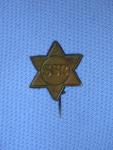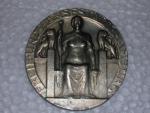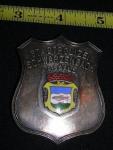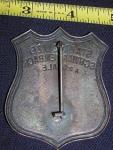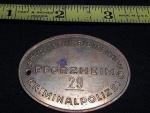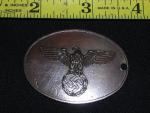-
Posts
237 -
Joined
-
Last visited
Content Type
Profiles
Forums
Blogs
Gallery
Events
Store
Everything posted by FireMedals
-

Hungary Hungarian Firemen's Medals
FireMedals replied to Gordon Craig's topic in Central & Eastern European States
Here is my contribution to the Hungarian Fire Medals discussion. I just got this nine medal bar, and assuming it?s a real group rather than a put-together-for-sale set, it seems what might be a standard volunteer firemans set of awards. I just have a couple of questions of my own that someone may be able to answer. FireMedals -

Fake ID tags ?
FireMedals replied to FireMedals's topic in Germany: Third Reich: Uniforms, Headwear, Insignia & Equipment
JoeW, I appreciate the information on the tags and badge. I'm surprised any of them are real, given what I've heard about copies of these types of items. I probably will be parting with them all, but haven't thought about how or what to ask. I'll keep you in mind. Thanks FireMedals -
I have a small (about 2.4 mm across) brass pin. The only markings are SSB in the center and a small o in the top point of the star. It's fairly crudely made, being stamped from sheet brass with unfinished edges. The reverse has a pin in a little soldered on attachment and a C catch. I've heard two or three stories, but nothing I've ever been able to verify. Anyone seen this before??? FireMedals
-
I picked up this Hamburg fire brigade medal that I haven?t seen before. The obv. has FREIE UND HANSESTAD HAMBURG. The rev. HAMBURGER FEUERWEHR. It?s 42mm, cast in what appears to be a zinc material. The casting is generally o.k. except for the centers where the grainy finish tends to show. Is anyone else familiar with this piece? Some of the design appears 19th or early 20th century, while others areas look 1920-30?s. I?m wondering if it?s a cast copy of a real silver medal, or just a souvenir item to recognize the fire brigade. FireMedals
-
I bought a box of misc. militaria at an auction over the weekend and found these in the bottom of the pile. I?m sure I?ve seen these ID?d as fake police tags or the like, but thought they would be worth a run by persons with better knowledge of German stuff than me (that?s pretty much everybody). 1. has a dark finish over copper. 2. is a non-magnetic white metal and 3. is a brassy color with an applied coat of arms for PFORZHEIM, the same name as on the reverse. I am curious about the last item. It?s marked STADTPOLIZEI / SCHWARZENBACH / A.D. SAALE .There is a nice color enameled coat of arms in the center, and the metal isn?t silver (also non-magnetic), but has developed a nice patina. There is even a substantial pin on the back. It seems like someone went to a lot of effort if this is a fake. Any comment would be appreciated. I tried a forum search, but couldn't find a match. If these are the usual fakes, perhaps someone could move them into the fake section for reference. FireMedals
-

Bundesrepublik Fire brigade medals?
FireMedals replied to Troy Tempest's topic in Germany: Post 1945: Bundesrepublik & DDR
Troy Yup. About 40 years worth...and still finding new ones. FireMedals -

Bundesrepublik Fire brigade medals?
FireMedals replied to Troy Tempest's topic in Germany: Post 1945: Bundesrepublik & DDR
Troy Tempest I can't see enought of the center of the first medal in post #1 to ID it. Medal #2 in post #1 is the 25 year LSM for Nordrhein Westfalen, instituted about 1954. The third medal from Hauptman, with the three lions in the center, is from Wurttemberg, also 25 year LSM, instituted around 1956. All are fairly common in the silver grade. FireMedals -
Dave, If you have a reference to the WWI Occupation being given for WWII Occupation service, can you send me the source. I'd love to document that. As far as his other awards, I would think a man who entered the Army right after WWI, and qualified for the WWI Occupation, spent the inter-war years doing his time on active duty, and got to Europe again in 44-45 (possibly at the age of 44-45 y.o.) as a senior Sgt. could certainly qualify for the CIB. Maybe to some of you guys 45 y.o. is over the hill, but I knew some good senior NCO's in SEA who had both WWII and Korea service, and they hadn't slowed down a bit. the Army Good Conduct ribbon (with 2 bronze knots) the American Defence ribbon (with one bronze star) the American Campain ribbon the Europe-Africa-Middle East ribbon (with 3 bronze stars) the Combat Infantry Badge These point to a man in the service pre- 7 Dec., and with three campaign stars, he certainly could have seen enought combat for a CIB. DetroitPC - you should request a service file on him. It would be interesting to confirm if any of our theories is close. FireMedals
-
DetroitPC If these were your ex-great uncle, he either had an interesting military career, or your missing some ribbons. If these are his only ribbons the WWI Occupation would be first (on the viewers left) and the WWII Victory to the right. The VFW Membership Medal ribbon is unofficial and wouldn't be on the bar, except for a veteran wearing it after his discharge, when it would be worn after any regulation awards (but vets' dress to their own regulations). The interesting thing is, if this is his total medal entitlement, he entered the US service after Nov. 11, 1918 (the cut-off date for the WWI Victory Medal) yet managed to get to Germany for Occupation duty, the qualification time, I think, ended in July 1923. Then the WWII Victory was issued for at least one day of service between 7 Dec. 1941 and 31 Dec. 1946. Odd he wouldn't have had enough time in for at least an American Campaign, or a Good Conduct Medal (if Army). However I had a US Navy group to a WWI sailor who got out in the 30's and got recalled in 41, but got sick and discharged, and his only entitlement was a WWII Victory. While the US ribbons aren't as easy to read as some the the great German bars on the GMIC, it's still fun to try. FireMedals
-
O.K. ... a Carpenter's Wood Plane would fit in, as the "square" used in the logo is actually a carpenter's folding ruler, not a builders square. So this was (is?) probably a fraternal society of carpenters, woodworkers, etc.. Also possibly a union. FireMedals
-
Mike, Between 1850 and 1950 there were dozens of fraternal organizations who modeled their ritual, secret signs...and insignia on the Freemasons. In order to keep peace, these groups made changes in the square and compass design so it wasn't an exact copy, but some were verrrrry close. The one I like is a group called the Junior Order United American Mechanics (JOUAM), the "mechanics" actually referring to almost anyone who worked as a craftsman, not just an auto shop employee. The JOUAM took the "G" from the center of the Masonic symbol and replaced it with a raised arm holding a hammer... that curiously looked just like a "G" to the average viewer. I am not immediately familiar with the symbol you found, but it is one of those many groups. There are some that I don't think have ever been truly identified, as they died out and few records survived. I'll try to look through some of the references I have for more information. Perhaps some of the other members are familiar with it. FireMedals BTW - What is the shape in the center of the design?
-

GSM and WWII Group to a civilian
FireMedals replied to geoff's topic in Great Britain: Orders, Gallantry, Campaign Medals
I'm not a general collector of British medals, but I seem to recall an article in an old OMRS Journal about the GSM and how some specialized civilian types; electronic tech's, factory reps, etc., who were directly assigned to units could qualify for the GSM. I believe the majority of such recipients were RAF aircraft technicians who were doing work the regular RAF people weren't trained for. I have two GSM's in my collection to RAF and Army fire brigade members, and I'm pretty sure one was a civilian. However, both are shown as fire service on the rim lettering. Haven't tried to research them since the new open archives policy kicked in. FireMedals -
Mott5ranch No offense meant about your friends father not being an officer. The Officer Specialty Code confirms that. I was just thinking out loud because of the inclusion of the Good Conduct Medals. I thought he might have had enlisted service as an Aircrew, maybe Flight Engineer, then got a commission, or perhaps did his regular service and got a commission in the Reserves. Obviously not the case. But, as has been noted, even 214's are filled out by people who can add or omit for who knows why. Check if your friend's father still has a rack of ribbons he may have worn, and see what he had showing then. Still, the GCM's are a weird addition. PaulR - The AF Commendation Medal is certainly not an unusual award to officers. But it seems it was awarded toward the end of this guy's career. Ordinarily you might expect him to get some type of retirement gong, usually a Legion of Merit, but even a MSM would be nice. Perhaps the AFCM was simply a commendation for his normal work, and he didn't get a special retirement award. Things were a little different in the 1960's, so that may not have been out of line. Perhaps there are some Air Force vets from that time period on board who might add to the discussion. Regardless, this case is a prefect example for those collectors who love to tell you "...That's impossible!!!... it could never happen...it's against regulation!!! " DD214's can be wrong, vet's can have perfect service records that defy logic, and perhaps here is an officer who was authorized a Good Conduct Medal. Look forward to reading more. Thanks for asking the questions Mott5ranch. Firemedals
-
Mott5ranch 1 - PUC = Presidential Unit Citation; authorized by GO (General Order) in the MTO (Mediterranean Theater of Operation, Jan. 1945 2. AM = Air Medal, with 8 OLC (Oak Leaf Clusters) authorized by GO 27 in the MTO May 1944 [Air Medals were generally issued for every 5 combat missions, so 8 + the medal + 45 missions] 3. DFC = Distinguished Flying Cross authorized SO (Squadron Order) MTO Aug. 1944 4. EAME = European-African- Mideast Theatre of Operation [The vet didn't serve in the Pacific but in the Mediterranean area according to his medals. Also, he should show a number representing the number of campaigns he served in while in the MTO.] 5. WWII Victory medal 6. AFRM = Armed Forces Reserve Medal for 10 years Reserve service 7. NDSM = National Defense Service Medal 8. Army of Occupation WWII 9. American Campaign authorized by Air Force Regulation 35-50 10. AFLSAR = Air Force Longevity Service Award Ribbon with 3 bronze OLC. the ribbon was for four years service, and each OLC indicates 4 more years, thus 16 years in the Air Force. 11. AFLSA = I believe this is avariation in naming for the Air Force Good Conduct Medal, 4 bronze Oak Leaf Clusters and the medal meaning 15 years service in the Air Force. 12. AFRESM = Armed Forces Reserve Medal, authorized by AFR (Air Force Regulation 900-10 , with HGD (not HCD) for Hour Glass Devise indication another 10 years of qualifying time. 13. GCM = Good Conduct Medal autorized by Paragraph 250 PB 24 ?? 6346 PT Wing (don't recall what unit PT referrs to) 1962. [The Good Conduct Medal seems out of place to an officer.] 14. AFCM = Air Force Commendation Medal authorized by headquartes ATC (Air Training Command) in 1965. [This may have been a retirement award since his active duty seems to have ended about that time. Again, an unusual retirement award for an officer...even in the 60's. Are you sure he was an officer??) FireMedals
-

Can anyone identify the branch of service ?
FireMedals replied to Hendrik's topic in United States of America
Hendrik, You might want to take a closer look at the ribbons. The US WWI Occupation of Germany medal (and ribbon) wasn't created until November 1941. Unless this is a post-WWII image of an old vet in his WWI uniform... possible I suppose. The pin below the ribbons is too blurry for my old eyes, but it doesn't look like a US WWI discharge pin. They were circular, in bronze or silver (wounded). This one seems more like a commemorative pin, or something from a vet's organization. Also, can you mention why you say he's a Belgian with US Forces? Firemedals -

Hungary Hungarian Firemen's Medals
FireMedals replied to Gordon Craig's topic in Central & Eastern European States
Zsolt, Thanks for posting these photos and descriptions. I've been trying to make sense of the Hungarian Fire award system for years. Now you have answered some of my questions and shown me photos of medals I didn't know existed. You can always learn something on this forum. It appears several of the Fire Brigade medals are almost identical, with the difference appearing in the wording. In my notes on the Factory Fire Brigade medals, I had the following information. Any corrections would be appreciated. ... the word ??VES? on the front is "years", inscribed above ?V?LLALATI T?ZOLT?I SZOLG?LATERT? (Workplace Fire Brigades); the reverse dated ?1958? and circumscribed ?BEL?GYMINISZT?RIUM T?ZOLT?S?G ORS?GOS PARANCSNOKS?G (Interior Ministry National Fire Service); The medal was awarded by the Ministry of the Interior, the first award of the medal was for completion of 5 years? active duty in the auxiliary fire brigades of workplaces such as factories and offices. I have a note that there was also a medal for Fire Police, similar to several of these styles, but with different lettering. Is that correct? FireMedals -
Buterbrodov, Welcome to the Club, and the Masonic-related section. Thanks for the link for the book, and several other nice references of Masonic interest. While we're giving reference works, I'll add my main source of information; The International Encyclopedia of Secret Societies & Fraternal Orders, by Alan Axelrod. Published by Facts On File, Inc, 1997. The ISBN number is 0-8160-2307-7. It's mostly about US related organizations, but also covers many of those with a foreign connection, and some really obscure ones. FireMedals
-
Mike, What you found is one of the dozens of fraternal organizations that sprang up in the US in the late 19th and early 20th Century. It is NOT Masonic in the sense that it is part of Freemasonry. What most of these organizations did was to copy the use of Masonic images, even to the point of widely using the Square and Compasses. What most groups did was to put their own logo or special insignia in the center. My grandfather belonged to a group called the Junior Order United American Mechanics [mechanic meaning anyone who worked in a trade...not like an auto mechanic today]. The JOUAM used the S&C design, but to keep out of trouble with the Masons, who protected the use of the letter "G" in the center, the JOUAM used an arm holding a hammer. I can't be sure of this group, because there were so many, and there are so few recorded histories, but it could be an organization like the Fraternal Patriotic Order of Americans [FPA]. I know, the "O" is missing, but many of these groups don't appear to have been sticklers for detail. The Fraternal Patriotic Order of Americans was founded about 1913, probably short-lived, and I believe long gone today. They believed in (1) separation of church and state and (2) promoting the reading of the Bible in public schools. [Think about it... kind of an oxymoron, but not to different than today where some groups want the government to stay out of their church, but want their Bible read in public school classes everyday.] Many had watch fobs, rings, lapel pins, and other jewelry produced for the membership. Anyway, I think this would be the general class of organization your looking at. There were other groups who called themselves Protective Associations, such as the MPA, or Masonic Protective Association. These groups acted like insurance companies at a time when there were few protections for workmen killed or injured on the job. The PA's would collect dues and pay after and injury or death, and were quite common. My grandfather's JOUAM had such a provision. However, due to the presence of the Bible and a school house on the medallion shown, I would go with the groups as described above. The piece is probably "rare" in that few were ever made and fewer still survive, but the opening bid is way out of line unless you're a hard-core collector. Also, for anyone looking for a research project that will take a few years to complete and offer nothing in financial reward, just the satisfaction of doing some serious research on a little known area of medals and organizations....this is your project. FireMedals
-

Ribbon bar of French Association of Civic Devotion
FireMedals replied to webr55's topic in Northern European & Baltic States
Christophe, Thanks for the pix. I've only seen the cross. FireMedals -

Ribbon bar of French Association of Civic Devotion
FireMedals replied to webr55's topic in Northern European & Baltic States
Hate to bring everyone back to reality...but this is a private French society or association medal for the Association of Civic Devotion. Don't know the particulars, perhaps one of the French members can help with that. The ribbon bar is of a style occasionally seen from the post-WWI era, and even appears on some styles of US ribbons purchased overseas. FireMedals -
There are wrap-brooch Bronze Star medals...those produced for the Navy. Wrap broochs were used on several medals introduced in WWII, the Legion of Merit and the Navy & Marine Corps Medal to name two. I've had two over the years that were well documented to the sea services, and have seen others. Unfortunately there are a lot of original period wrap brooches around, and it's easy to alter them. A more accurate check of Navy vs. Army awards of the BS is to check the thickness. The Navy strikes are noticeably thicker when compared to an Army piece. I don't have the specfications on the thickness of each, but it is easy to see when compared. The reason for the differences is due to the fact that the Army and Navy each produced their own manufacturing specifications. The Navy WWII versions of the Silver Star and Distinguished Flying Cross are both thicker than the cooresponding Army version. Also, as most of the war produced decorations were made by the US Mint, and bronze was in short supply, the stocks of wrap brooches were there to be used, and were. There were instances where the services "borrowed" awards from each other, the most well known being the Navy use of the Army Purple Hearts. The Marine Corps was handing them out so quick in the Pacific, production couldn't keep up with demand. So it is not unusual to find an Army style PH issued to a Navy casualty. But that's for another thread. FireMedals




